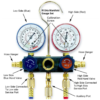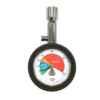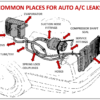A Guide to Compressors with Mr. Fixit
Automotive air conditioning systems are self-contained structures which cool the cabin of a vehicle by changing the phase of refrigerant from gas to liquid and back again by applying and releasing pressure on it. The ability of refrigerant gas to change its physical properties as it is compressed and cooled is what makes the air conditioning system produce cool air.
Like a heart, the compressor is a pump which pushes and pulls the refrigerant through the AC system line. As it pumps the refrigerant it also compresses it from a low pressure gas to a high pressure gas. This high pressure also heats the refrigerant. Because of its high pressure contents, this called the “high side” of the system.
There are several different types of compressors, but they all elicit the same result: change the phase of refrigerant to create air conditioning while pumping it through the hoses and pipes, condenser, evaporator and other parts of the system.
Compressors can, and do, fail. Whether the issue is simple age/wear and tear, broken switch, significant refrigerant loss, blown fuse, collision, or other cause, its important to get to the root of the issue as quickly as possible to prevent potential further damage. Sometimes the problem could be as simple as a loss of refrigerant
Compressors can fail for many different reasons: bad fuses, wear and tear, age, a wiring problem, improper maintenance, a broken AC switch in your dash, etc. Keep in mind, A/C compressors are designed to only come on when there is enough refrigerant to compress. So, if your compressor is not running, that could be a sign that it is working as designed, and simply needs more refrigerant. Most systems have a low-pressure safety cutout that will disable the compressor if there isn’t enough refrigerant in the system. The first thing you’ll want to check is if your compressor is engaged.
How can I tell if a compressor is engaged?
If the compressor is engaged, the center of the compressor clutch will turn with the outer pulley, on certain types of compressors. (Please note that on variable displacement compressors the center of the pulley can be spinning at all times.) If you have specific questions about whether your compressor is working properly, please consult a professional mechanic.
If you determine your compressor is functioning properly, you can check your refrigerant using an FJC manifold gauge set to determine if low refrigerant levels are at the root of warm air blowing from your system.

LMK 2022






